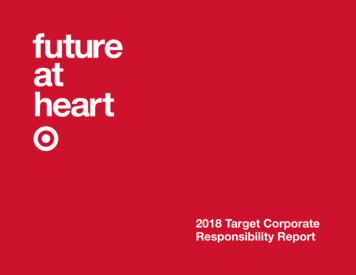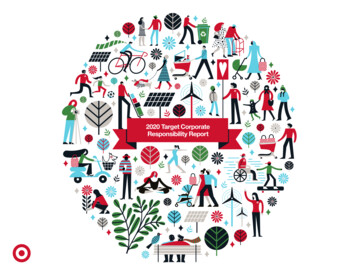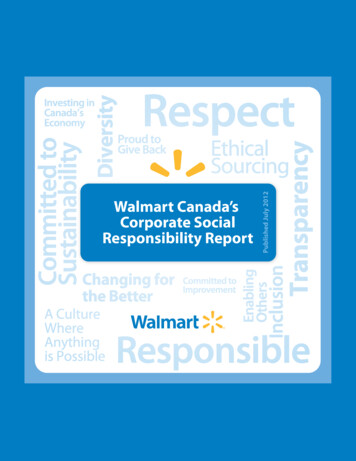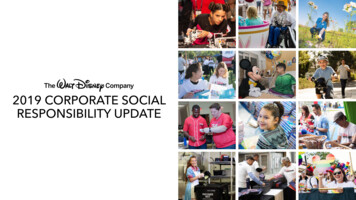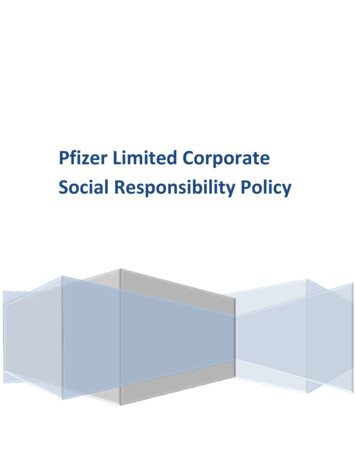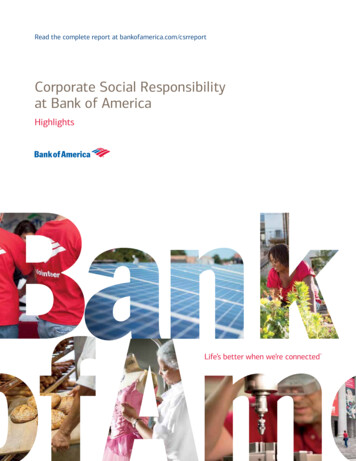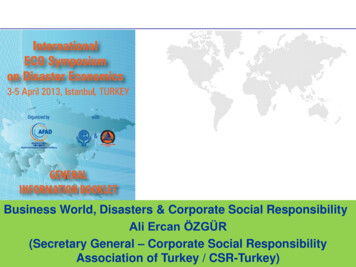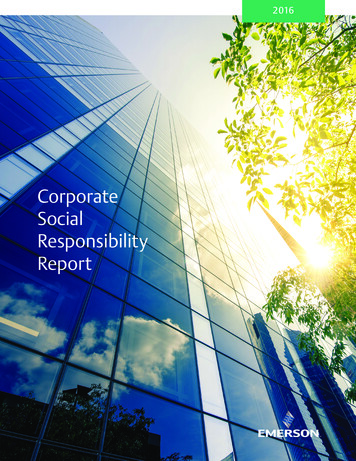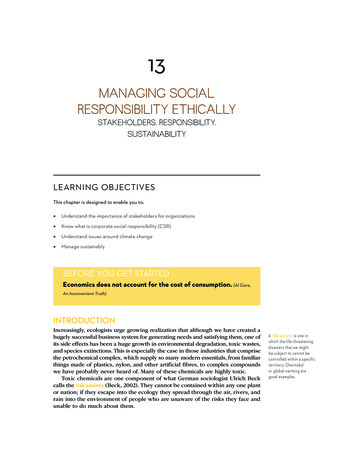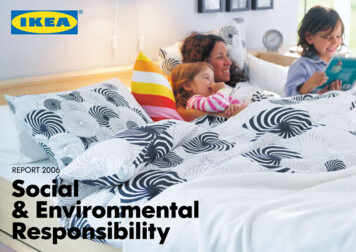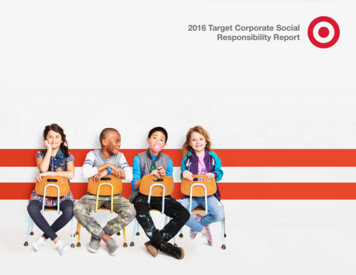
Transcription
2016 Target Corporate SocialResponsibility Report
Our CoverOur report cover proudly features ourCat & Jack apparel line, designed with kids,for kids. Along with being high quality andaffordable, the brand also uses sustainablematerials in many of its items, includingrecycled polyester made from plasticbottles in its girls' denim and swimwearand GOTS-certified organic cotton andsafe dyes in its baby layette collection.Table of ContentsMessage From Our Board Chairman & CEOQ&A With Our VP of CSRMateriality ProcessStakeholder EngagementGoalsProducts: Inspiring Solutions For Better LivingTeam: Valuing Our Team MembersCommunities: Strengthening Our Global NeighborhoodsPlanet: Driving Positive ImpactReporting & Additional InformationGRI Index
A Message to Our StakeholdersTarget has long been a place that brings people together.We take pride in helping families discover joy in theireveryday lives, whether it’s by making a weekly TargetRun, finding a new outfit for their newborn or runninginto a neighbor at one of the hundreds of communityprojects we sponsor each year.Our guests shop with us knowing they can expect more,not only in the experience and products we offer, but inthe high standards we hold ourselves to as a company.Target has a longstanding legacy of investing in ourcommunities. Since 1946 we have donated five percentof our annual profits, today that’s millions of dollars eachweek, back to the communities we serve.But as much as we value philanthropy, we also knowcommunity giving is just the start.We believe a truly successful company has a duty tonot only support, but lift up the communities it serves.We are thinking boldly about how we can leverageour size and scope to address global problems, fromreducing our environmental footprint to improvinglivelihoods at all points in our supply chain.And we are rallying our team around a common purposeand set of values.This means fostering a culture of inclusivity, where everyteam member, in every role at every level, feels they canbring their whole self to work each day. And it meansinfusing the power of connection—to each other, to thecommunities we serve and to the planet we occupy—into everything we do.We are proud of the progress we have made so far, andcommitted to continuous improvement.And this is just the beginning. The work of bringingpeople together is never-ending, and we are more thanup for the challenge.That’s why we work with suppliers, vendors andpartners who share our values and we hold them tohigh ethical standards.We are determined to find the best ways to support theUN Sustainable Development Goals of ending poverty,fighting inequality and protecting our planet. 2016 CSR ReportBrian C. CornellBoard Chairman and Chief Executive Officer3
Jennifer SilbermanVice President, Corporate Social ResponsibilityQ&A With Our VP of CSRQ: As Target’s Vice President of Corporate SocialResponsibility (CSR), what excites you most aboutTarget’s CSR efforts?A: With the power of Target’s team, and our scale asone of the country’s largest retailers, we hope to be acatalyst for change across the industry. And unlike anyother time, we have an opportunity to transform theguest experience beyond the register in a way that fulfillsour purpose and unlocks long-term business value.Q: How is Target’s CSR approach evolving to addressthe changing needs of stakeholders?A: Stakeholders play an important role in guiding ourstrategy and the work we do to deliver on ourcommitments and goals. Because the issues we faceare complex, and require industry-wide solutions, welook to work with others to drive collective impact.Increasingly, we know guests look for quality productsthat are good for them, their families and society. So wepartnered with several organizations that innovate waysto make better-for-you living accessible and attainable.One example is Wholesome Wave, a nonprofit thatincreases access to affordable, healthy produce.We are also increasing our commitment to protectand use natural resources wisely. To work toward this,we doubled down on solar installations and made ourfirst partnership in wind power. We were also namedENERGY STAR Partner of the Year for the second yearin a row.Because our team members are key to our success,we want to foster a culture that is diverse, inclusive andenables our team members to thrive. We were thrilled tobe recognized by DiversityInc for being one of the "Top50 Companies for Diversity."And we believe our strategy should support vibrantcommunities, including improving the livelihoods ofthe people who make our products. That’s why weset responsible sourcing goals with a focus on workerwell-being and safety throughout our supply chain.Q: What are you most proud of?A: I am really proud of how we made great strides to putour guests at the center of everything we do. Our newchemical strategy and policy is a great example of that.This ambitious strategy, focused on driving transparency,chemical management and innovation across everyproduct we sell and use throughout our businessoperations, is one of the most comprehensive in theU.S. retail industry. And we know it’s important to ourguests as they trust us to help them discover betterchoices for them and their families.Q: What does the future of CSR at Target look like?A: Looking forward, we are rethinking our approach toCSR at Target. We are building on our strong foundationof investing in our communities and sustainable businessoperations to identify new ways to unlock business andsocietal value. As a global corporate citizen, we believeit is our shared responsibility to tackle issues that notonly create business opportunities, but also ensure ourcommunities thrive. We are beginning to align our futurepriorities with the UN Sustainable Development Goalsand assume our responsibility in addressing this globalagenda.We can leverage our size, scale and value chain to drivereal change. From the products we source from 48countries and the more than 1,800 stores we operate,to the way we engage our guests—we can make ourbusiness economically, environmentally and sociallysustainable.4
Materiality ProcessAbility to Impact/InfluenceUnderstanding and prioritizing the corporate socialresponsibility (CSR) issues that matter to our business andour stakeholders (materiality assessment) enables us toaddress the right issues and report on them effectively. Italso allows us to focus our resources, evolve our strategyand tailor our reporting to align with the interests and needsof our business and our stakeholders.We recognize there are varying definitions of materiality—such as those from the Global Reporting Initiative orSustainability Accounting Standards Board (SASB), andmany ways to conduct a materiality assessment. In 2016,we revisited our prior materiality assessment processto evolve our strategy and stakeholder engagement.We sought to find a hybrid between the varying definitionsthat exist and created a broad and non-traditional definitionand methodology. Our methodology focused on socialand environmental issues and our definition considered theimpact to our business and the degree of impact/influencewe can have on the issue. This assessment leveraged aninternal process, which consisted of three key actions:Action 1-Identification:Target conducted a robust review of existing issues analysis,previous stakeholder engagement results and research into newtrends, competitor practices and global standards to generate a listof more than 400 potentially material environmental, economic andsocial issues. Sources included: Rating/Ranking Reports (six total), including the Dow JonesSustainability Index and CDP information request ESG Guidance Documents and Research Reports (six total),authored by organizations such as Ceres and SASB Materiality assessments completed by competitor or CSRleadership companies (11 total)We then removed duplicate issues and combined any issues that,while slightly different in wording or definition, were similar at thecore, to arrive at a list of 61 potentially material issues.Action 2-Assessment:We classified these 61 issues into 16 topics and ultimately fourfocus areas: Products, Team, Communities and Planet. This allowedus to have a more manageable list of topics to discuss, withoutlosing the granularity of key issues.Focus AreaTopicProducts Better products Better services and experiencesTeam Diverse workforce and inclusive workplace Skills for a lifetime Well-beingCommunities Global livelihoods Human rights Resilient and vibrant communitiesPlanet Climate and energyWaterWasteForestRaw materialsWe then assessed each of the 61 issues on two dimensions:1), importance to Target’s business, and 2), Target’s ability toimpact/influence the issue in question. While the “importanceto the business” dimension is standard in most materialityassessments, the “ability to impact/influence” dimension is lesscommon. To determine “importance to business,” we havetraditionally relied on qualitative inputs such as interviews withsubject matter experts. This year, we paired that qualitativeinformation with internal quantitative data, such as financialsand sourcing volumes by country, to elevate issues that couldhave the most significant impacts on Target’s business.Low business impactHigh degree of controlHigh business impactHigh degree of controlImpact to TargetLow business impactLow degree of controlHigh business impactLow degree of controlAction 3-Validation:To validate our process and test our internal methodology,we engaged BSR (Business for Social Responsibility), a globalnonprofit organization that works with its network of more than250 member companies and other partners to build a just andsustainable world. BSR conducted interviews on Target’s behalfwith a variety of external stakeholders and corporate socialresponsibility experts. The purpose was to determine whatconcerns exist with our process or methodology.This process highlighted three primary concerns: Limited stakeholder engagement early in the process comparedto previous approaches to materiality assessment Need for more granularity in issue definitions and a cleartranslation from materiality to strategy Need for further discussion around the context and motivationfor Target’s decision to pilot a new approach to materiality thatbetter facilitates stakeholder engagement and the evolution ofthe materiality practiceTo determine “ability to impact/influence,” we relied on qualitativeinputs such as interviews with internal subject matter experts andexternal research to understand environmental and social issuesby country around the world. We paired this information againstthree dimensions of our supply chain—raw materials, manufacturingand retail operations—to understand the level of impact we couldpotentially have on an issue.We take our commitment to continuous improvement seriously.We plan to take action on this feedback as part of our ongoingeffort to ensure the materiality assessment remains relevant in lightof changes in our business and socioeconomic and environmentaltrends. We will keep the materiality assessment under regularreview, and aim to be as responsive as possible to stakeholderneeds as critical issues arise.We organized the resulting issues according to the axes shownin fig. 1. This helped us to prioritize our resources and focus onthe issues that matter most to our business (categorized in the topright quadrant), but we may also take action on the issues in theother quadrants.In 2017, we will engage internal stakeholders to define and translatepriority issues into our CSR approach. In addition, we plan toevolve our external stakeholder engagement approach to ensuremateriality is part of the conversation throughout the year.Materiality Process5
StakeholderEngagementAt Target, we aim to leverage our size, scale and reachto positively impact the communities in which we serveand operate. Going beyond what we can achieve in ourown operations and with our vendors, we collaboratewith NGOs, governments, industry organizations andother businesses to innovate solutions to the mostpressing issues we face today. To the right is anoverview of the groups we engaged in 2016, how thosegroups were engaged, the issues they raised and whatTarget is doing to respond to their feedback. Thestakeholder engagements listed to the right do notinclude the additional stakeholder engagementconducted to validate our new corporate socialresponsibility materiality approach. Looking ahead, weplan to evolve our stakeholder engagement to ensureour materiality process is aligned with existingstakeholder engagements throughout the year.StakeholdersEngagedHow We Engaged ThemTop Issues RaisedInvestors Financial performanceResponsible sourcingCorporate governanceReduced emissionsWaste reductionRaw materialsDeforestationContinue to reach our goals and targets,and monitor the changing landscapes toensure we are doing our part to addressenvironmental and social issues materialto our business while continuing to drivemeaningful business results.Civil SocietyOrganizations Participation in conferences and forums Public-private partnerships andengagement on select topics Strategic partnerships andconsultation around material issues Volunteer projects Grant recipient interactions Reduced emissionsReduced water useWaste reductionProduct ingredient safetyRaw materialsWorker well-beingEconomic vitalityWorkforce developmentCreative economySocial determinants of healthSocial service disparities/needsContinue to reach our goals and targetsset forth to ensure we are doing our partto address societal issues material to ourbusiness.VendorsAll vendors External partner website Annual meetings Trainings and workshops Vendor Code of ConductOwned-brand vendors Annual assessment Annual owned-brand vendor meeting Responsible sourcingFair wages and benefitsWorker well-beingRaw materialsNet-positive manufacturingShare our resources an
set responsible sourcing goals with a focus on worker priorities with the UN Sustainable Development Goals are complex, and require industry-wide solutions, we well-being and safety throughout our supply chain. and assume our responsibility in addressing this global look to work with others to drive collective impact. agenda. Increasingly, we know guests look for quality products Q:
